Proper Care & Storage: Collectible Firearms & Holsters
Entertaining & Educational
Hey guys! Today I'm going to do an educational and hopefully mildly entertaining, emphasis on mildly, educational and mildly entertaining video for you. Basically it's care and storage of your guns.
Gun Collecting 101
This is gun collecting 101. I'm going back to the beginning, because I have a lot of brand new collectors, people who haven't actually bought their first gun. And when they do they say, how do I take good care of it, because these are worthwhile investments? So I've been collecting for about 30 years, and never ruined a gun in storage. Now, we did pick up a collection, those of you who subscribed, you know about the Andrews collection, and we picked up a collection that got hurt in Louisiana by flooding, salt water, a lot of damage done to that. And so I'm going to refer to that in terms of when everything goes wrong. There's almost nothing you can do other than buy insurance. But under normal conditions, how do I store and preserve the guns, especially when I have both leather and metal, and I have to take into considerations, different parts of the world and different parts of the country. So let's have at it.
Let's start with Storage

Okay, I'm starting off with a couple of guns, these are rigs, but I'm going to pretend. Let's say this is an individual gun that I want to put into storage. So I use these boxes to store them, for obvious reasons. I can stack them in my safe, I get a lot more in there. Rather than having guns piled one on top of the other, I stack them in here, they're labeled with a label facing out. So when I go into my safe, I just look through and I can find by serial number, the gun that I'm looking for.
Unsolicited Advertisement
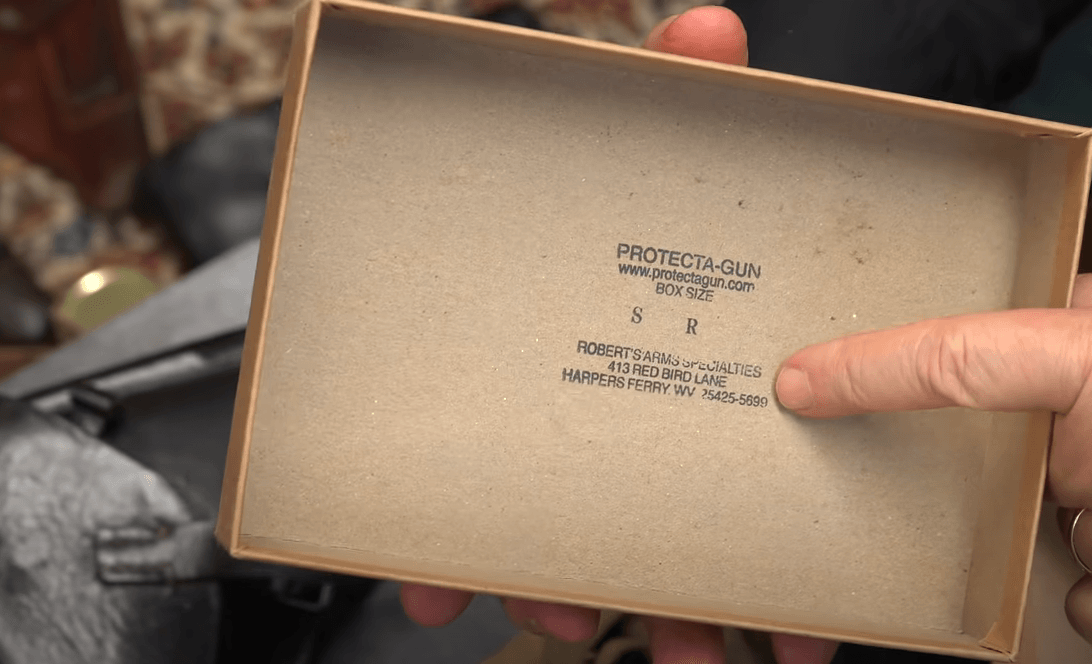
Now before I put them away in one of these boxes, and let's do some unsolicited advertising. You can buy these boxes through Roberts Arms, that's actually where I bought them. And I've saved up quite a bit. So now I don't even buy them anymore, I just recycle them. If this is in pencil, I can erase it and rewrite it, or I can just rip that off. Now there are other places obviously that sells boxes. So I have no affiliation with where you buy them.
Shhh! Here's a Hack
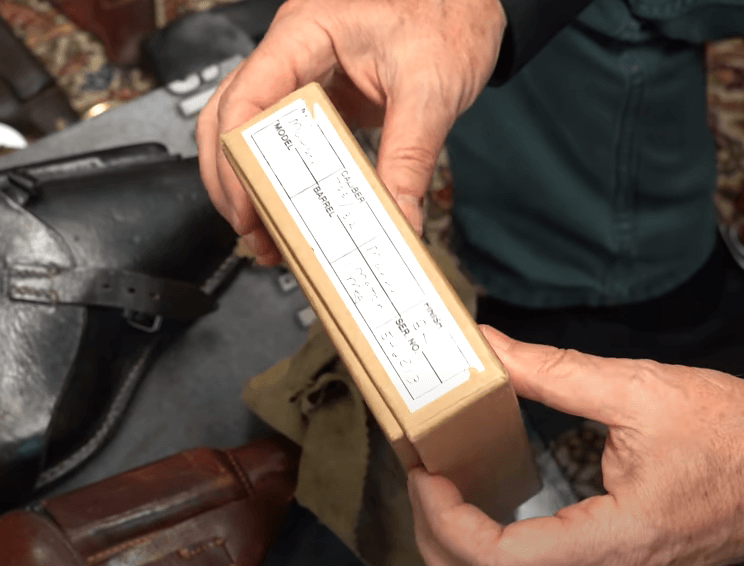
But there is one hack. Now that's a very cool term because I'm not a youth anymore. You know what a youth is. But for the young people, it's interesting, they talk about hacks. And when I was growing up a hack was somebody who was a doofus who couldn't quite do things right. And we'd say what a hack. But in this case here, here's a hack on buying these boxes. Now if you work for the federal government, you may not want to share this, or turn me in. But you can get these priority. These are a small flat rate box. And you can pop these together, actually, you can buy them. If you order them, they'll deliver them to your house, you can get 20 - 30 at a time, but look how quickly this goes together. That didn't pop it as easily together as it usually does. Maybe I was a little nervous being on camera and having thousands of people watching me. But this is possible and you could certainly label it with a magic marker here.
What size guns will the boxes fit?

And these will fit a small caliber weapon 7.65. SPPS, PPKs, Sauer’s, HSCs, this one I use for 1911s, Colt Revolvers, but also German Lugers and P38s. This will hold a Luger, you can see it will fit but just barely. So it'll slide down in there.
How do we put the guns in the box?
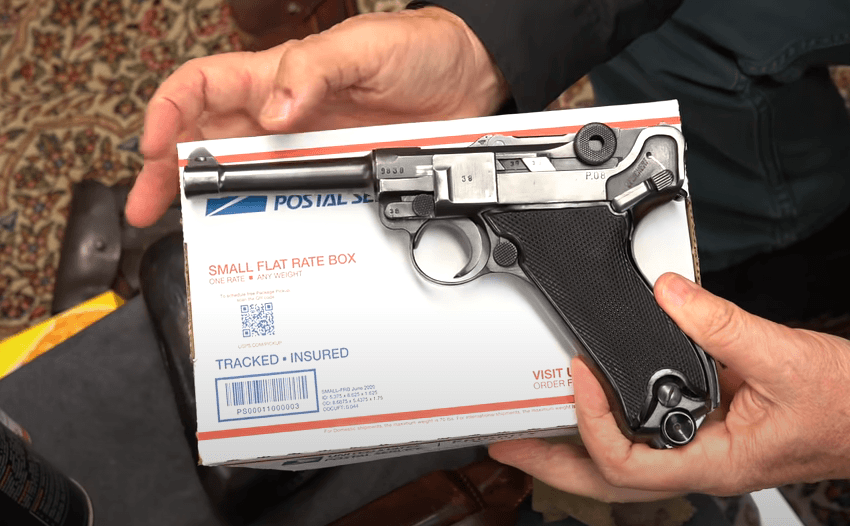
Now let's talk about how we put it in the box. Alright, so let's go back to the PPK, but this would apply to any gun that you might want to store. You want to make sure that you wipe it down. Now this is my dirty rag and it's dirty for a reason. It's just a lot of oil and grease and things but that's a good thing, because it just wipes it down gets rid of any corrosion or rust. You want to start off with a clean gun. That clean gun just means, for example, cleaner, lubricant and preservative. But I'm not working for this company. There's all kinds of gun oils. It's certainly worthwhile to get a quality gun oil that cleans lubricates and protects. So in terms of cleaning, I don't clean them first other than wiping them all down and then oiling them up. If it's particularly dirty, then you can get gun cleaners and get rid of all the oil and greasy build up. And that would be true of the Andrews collections. We have a gun a few guns here that you can see they were just filled with grease, the slides were filled with grease, so that all had to be cleaned up.
Hack #2
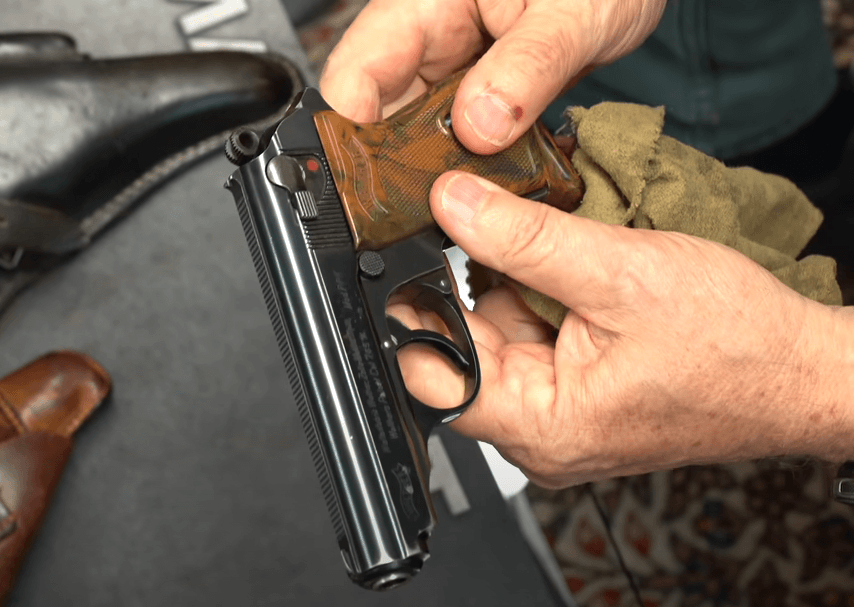
And another hack would be, I just went to the grocery store and got a gallon of vegetable oil. I put them in overnight, pull them out, and the grease just kind of disintegrated. So that was pretty easy. And now it's already oiled up once you put the vegetable oil on it.
Now the gun is all greased
But what I like about this is this is very penetrating. So when you put it on, for example, the firing pin assembly, I just squirt some on here, on this lever, I can just squirt some in there, or in this case, just put a couple drops. And it penetrates down into there. So that I don't have to worry about taking it all apart, it gets in on there. So I put a generous layer of oil over the whole thing.
Careful attention to the Grip
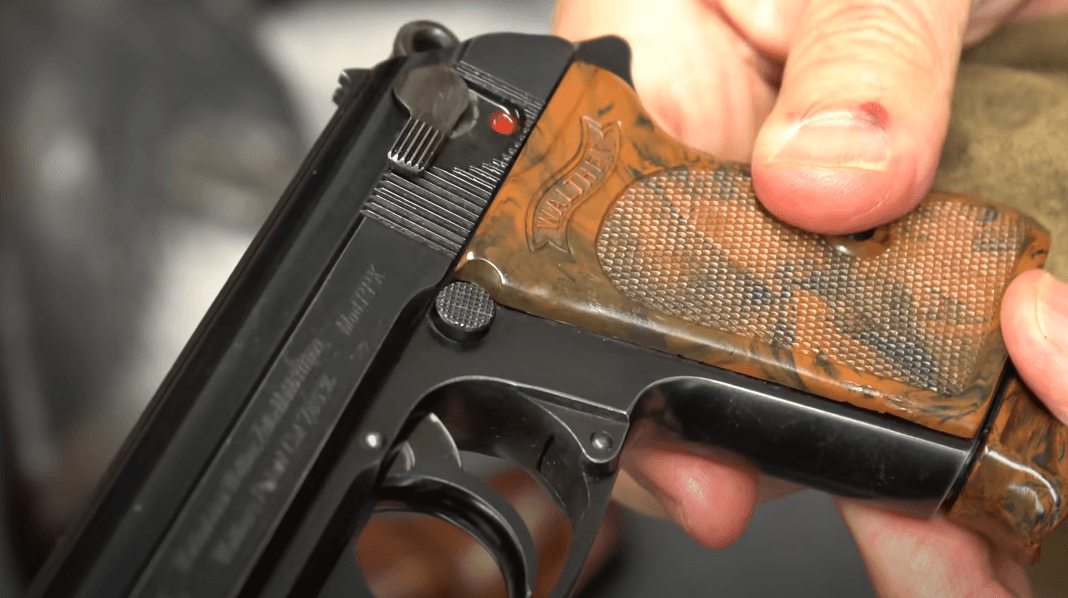
Now one thing to remember is the grip, if you can look right in here, if I took this grip off, you can see the waxy build up along there. And particularly for wood grip, a gun such as the Luger, or the HSC, any kind of wood grip, the wood will absorb moisture, even humidity. And then the wood just holds that against the gun. And so one of the most common places for me to see, even in well-kept guns, I'll take the grip off, and you'll find pitting on all inside because the grips were moist, and held up against the metal, and therefore cause damage. So you want to get under the grip, take the grip off, or in the case of other guns, you take both panels off and wipe them all down with oil. It doesn't need to be running off of there. Basically, I just put a little bit on and put a layer of oil. And don't forget the magazine. Sometimes I just store the magazine in the gun, and sometimes I'll put it beside the gun.
How to preserve the oil
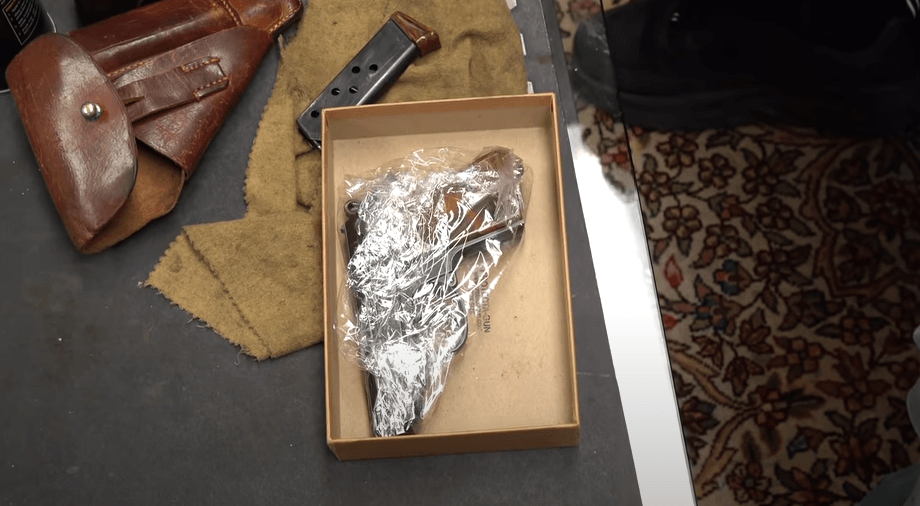
And then in order to preserve the oil, so it doesn't dry out too quickly, I just use my favorite little Glad wrap. It's real light, some people will use a vacuum pack, certainly if you're storing a lot of guns vacuum pack works even better. But this is cheap and very easy. I just get a piece like this. Now I want to accomplish two things. One, is I want to preserve the oil that's inside here. I don't always do this but in this case, let's take that off. And then I keep it kind of loose. I let it breathe, but it keeps the oil from evaporating too quickly. And that's all I do. Then I put it I put it in here. I then will wrap the magazine, particularly if I'm storing it in the holster, definitely I want to wrap the magazine. You don't need much just a quick turn. And again, I'm not wrapping the bottom and just maybe covering the top, break it off and store it like that. The main issue with storing in a holster and we're going to spend more time storing in a holster, the main issue is the acids from the leather or the leather preservative that's on here, we don't want that up against the metal. So all we're doing is creating a very thin barrier, kind of like a prophylactic. A very thin barrier between the leather and the metal.
I like to keep it loose
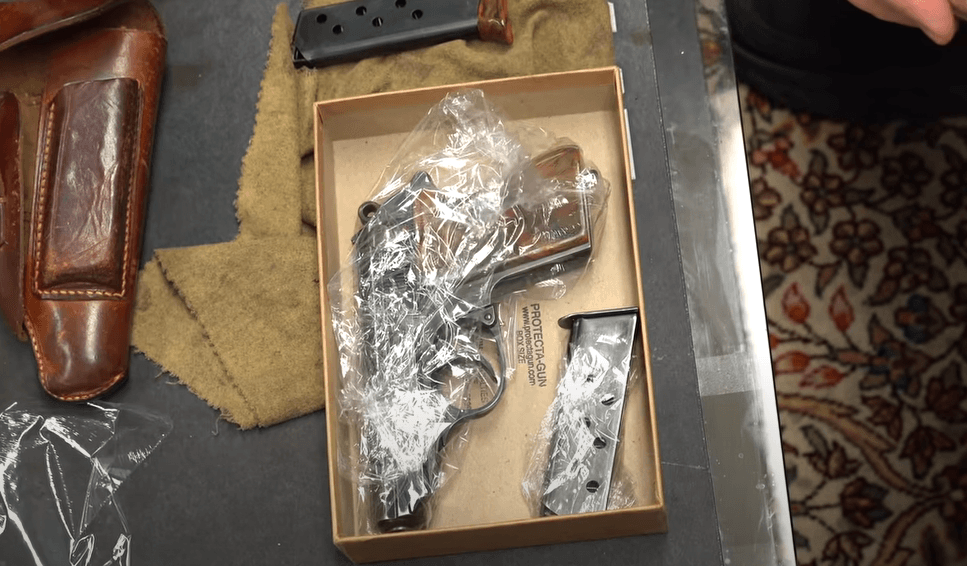
In this case, let's say I'm storing it like this. I just keep them again, I keep them loose. And I'm not the most knowledgeable person in the world. But it's worked for me for 30 years. I don't need it wrapped real tight, airtight. In some ways, I want it to breathe a little bit. And what I find is when it's covered with oil, a generous amount of oil, and I keep it wrapped, the oil doesn't evaporate, it's still oily when I check it and I only check my guns about once a year.
How often do you check your guns?
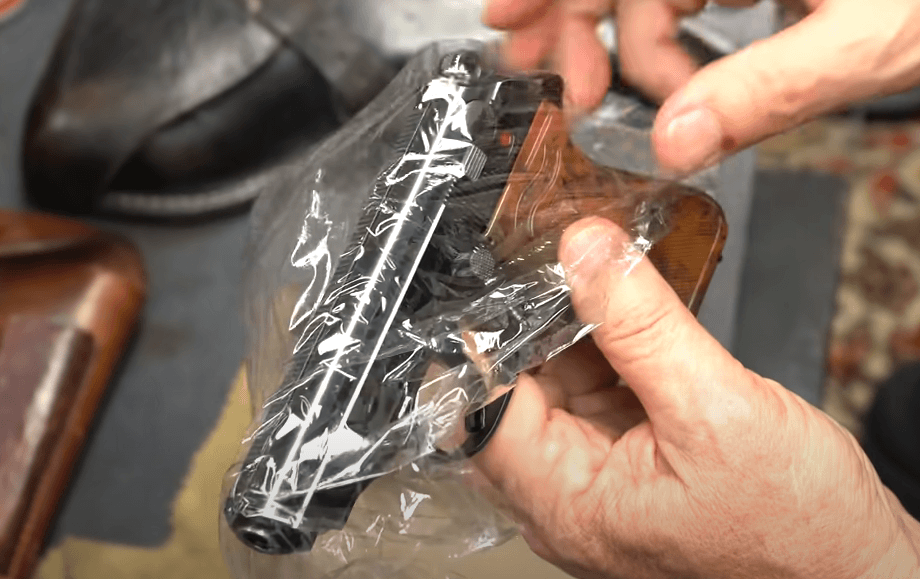
Now, if I have 100 guns in the safe, that's an all day job. Some of you if you have two or three and you can't stand to not be with your guns on a regular basis. Sure, check on them a couple times a month if you want. There's not a limit other than I would not go beyond a year. I have found people's collections where nobody attended to him for five years. I have seen where the cellophane it turns dark and comes becomes brittle and just flakes off. And then I've actually seen where the where the cellophane up against here. When I pulled it off, it would make a mark in the slide. But again, that doesn't happen a period of a year, that's five years or more. So check your guns once a year. Keep them wrapped in cellophane, store them in a box and put them in the safe.
What is considered as a rig?
Okay, next I'm going to give you my formula for Rigatoni. No actually, putting together rigs. Now, this is some background information. What constitutes a rig? Well, for a gun like a PP or PPK, most of your 32 calibers rig is generally considered the holster, the gun and a spare magazine. That's what most people would consider a rig. So when they say it comes as a complete rig. Now for some people, a complete rig would include also the belt and the buckle. It's up to the individual, I don't always put a belt and a buckle, I don't collect belts and buckles. And to be honest, all this stuff won't fit in my safe. So I do take complete rigs, and I do store them in the safe. By the way, notice that? That is a pickle ball injury got hit and it's my war wound. So I wear it proudly. But anyway, getting back to my rigs.
Sometimes you want to keep things together
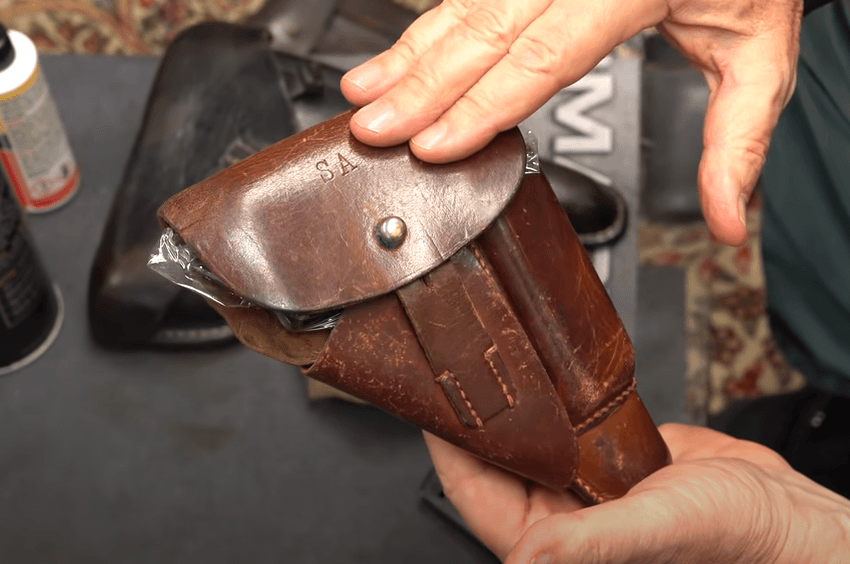
When I want to keep a holster with the gun. And in this, this is a great example of keeping the holster with the gun because this is marked SA. Now this is not factory because that is not an SA holster. But this writing looks to me to be period correct and that's a Standaarte Gruppe of the SA, and the serial number is written right here that matches the gun. So in my opinion, these came together and were captured together. So I want to keep them together. Now I don't know about you. But if you collect a lot of guns and let's say you put this in a box and you throw this in another box, and you keep them separate, 20 years from now, let alone when I die and my kids are going through my stuff, these are going to get separated. So my goal is to keep them together. And there are advantages to keeping them together. One, you can find them later altogether. And by the way, capture papers are the same thing.
I find a way to keep the capture papers, maybe I put a tie through here and attach it and staple it to the cellophane that I have the capture paper wrapped up in I keep them all together because they do get separated and lost. The other reason I want to keep them together is it helps it keeps its form. You'll notice this holster has kept its form, as opposed to this holster. This holster is actually a very valuable holster, in that it is Waffen stamped, it fits a PP or PPK, it's a rare Waffen stamp, but somebody just put it in a safe and piled stuff on top of it. So the mag pouch is smashed, this is smashed, it’s lost its form. And if it had been kept with a gun and the spare magazine in it, it would have kept its form. So it's it protects your gun, it keeps the raid together, it doesn't look better now. It keeps its form. So I store them together.
Now, once again, I'm going to oil this down. The spare magazine already is wrapped in cellophane. I then wrap this in cellophane. Again, oil it all down first, make sure you get under the grip, wrap it up in cellophane, pop it in there and it creates a barrier. Remember the acids from the leather and the dyeing process and the preservative. You want to keep those chemicals away from the metal parts of the gun. And this does the trick. And like I said, I've done this for 30 years, I've never had a problem in storage of my guns in the last 30 years and that includes letting them sit for up to a year.
Rigs won't fit in a box
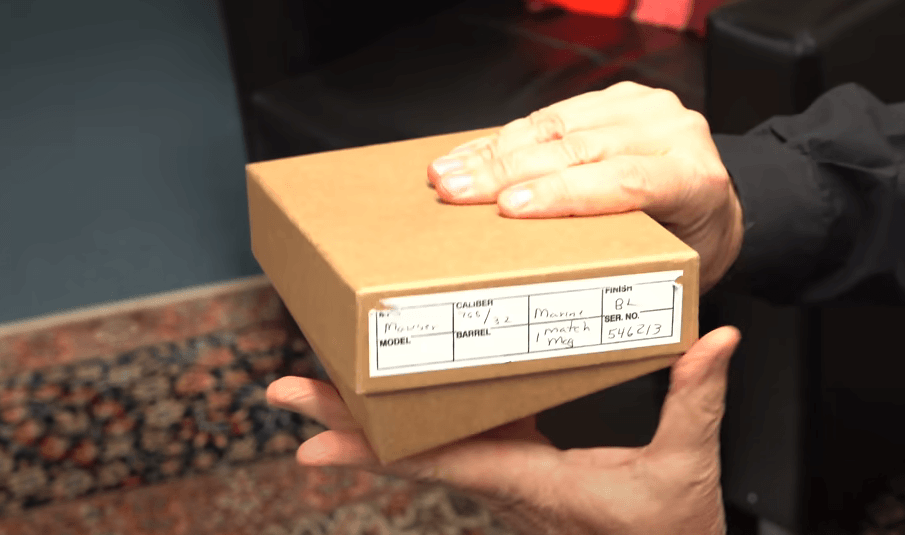
Now these I don't put in a box because they don't quite fit. So the bottom shelf of my safe is just filled with rigs. If I put this in here it would work, but you can see that when I go to stack them it just doesn't work right. It defeats the purpose. So I just pile these rigs in the bottom shelf and you can never have too much rigatoni.
What about a Colt 45 Rig?
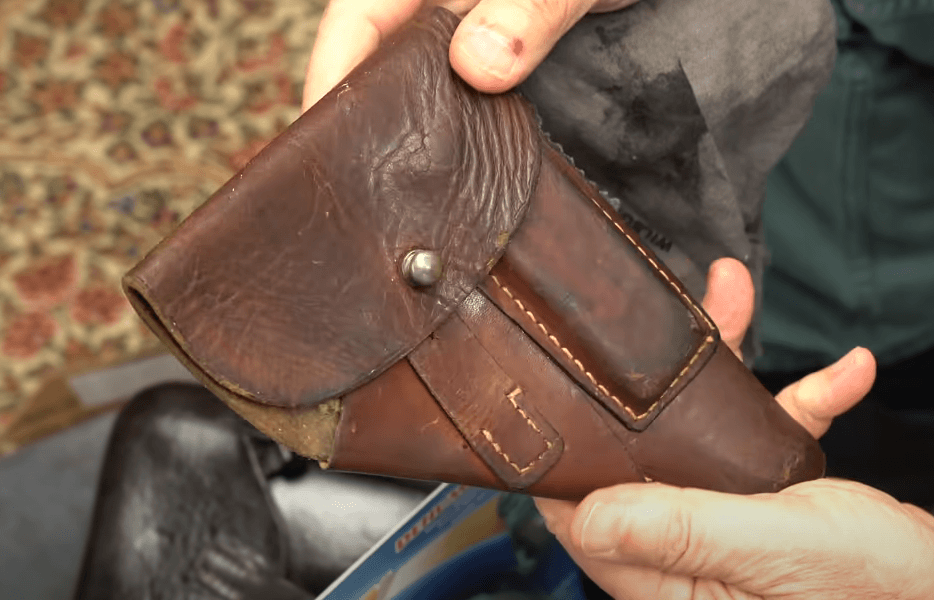
All right, let's take a look at other rigs. If you take the Colt 45. It comes with a very simple holster and there is no spare pouch, other than if you have the belt a lot of people will get the web, the canteen, the spare mag pouch, the ammo pouch is very very cool. And I have I have bought complete 1911 Colts from World War II all rigged out. Very cool, but it is hard to keep all of that in your safe. If you put them on display. Then it's the same thing. You can keep it all together and just make sure you put a layer of cellophane between the gun and the holster.
Artillery Luger Rig, straight from the safe
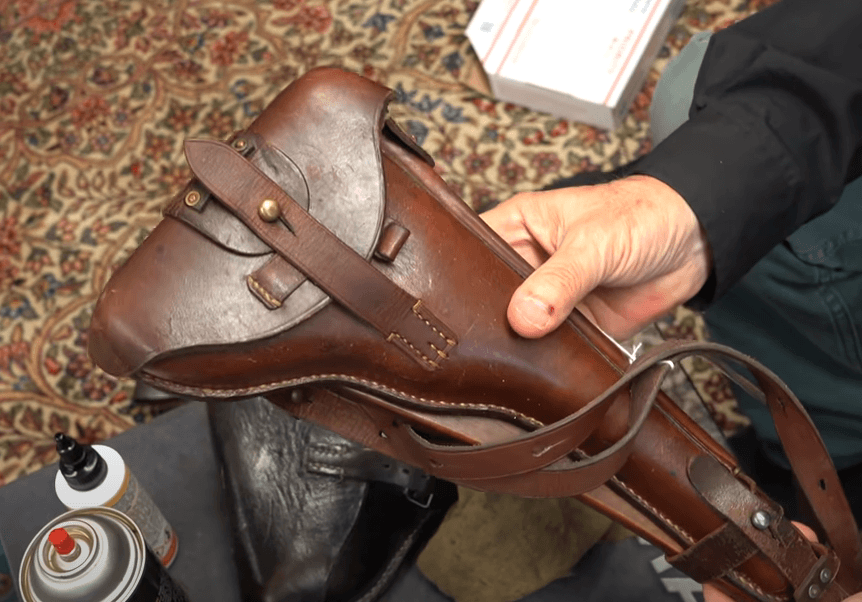
Another big rig that you'll see is the Artillery Luger. Here's our artillery Luger that came straight from my safe and in this case, it's the board, the strap. The strap often will have a two mag pouch here and the holster everything goes together. Now, on the inside you'll have a tool in here, you can see the tool. You can see this is wrapped in cellophane. Again, straight from my safe. This is the way I store them. And it's been in there for at least a year there's the tool. I didn't wrap the tool, I could, it hasn't been a problem. If you're extra careful you can wrap the tool and the cleaning rod same thing. Cleaning rod is often brass, this one is not but there's the cleaning rod and I could wrap that as well. So all of this is the way it would be stored in my safe.
How to care for Leather
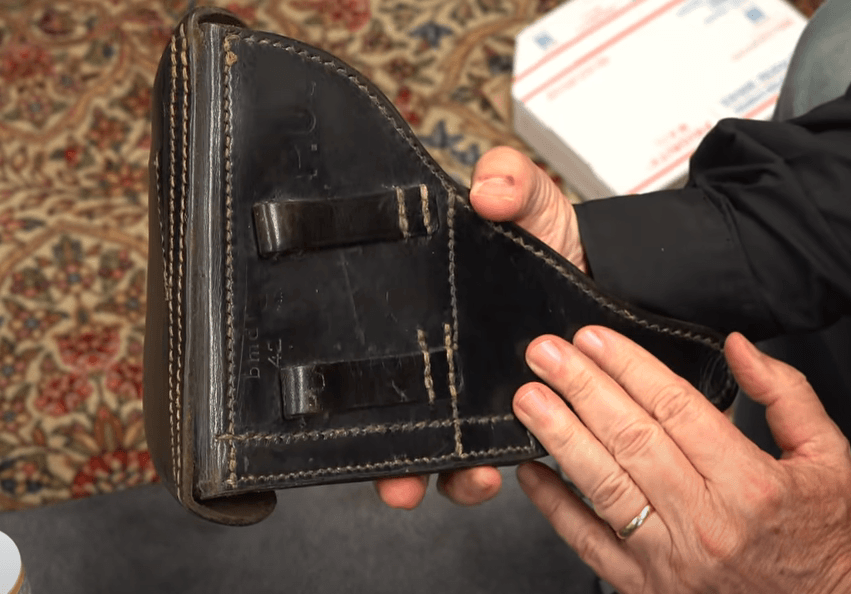
Okay, let's talk about leather care. Now there's two extremes here. Actually here's the extremes. There's a beautiful holster that's been well cared for, beautiful holster in beautiful shape. I don't do anything with this other than if I feel like the leather needs to be cleaned and preserved, I use this product it's actually for boots and saddles.
Hack #3
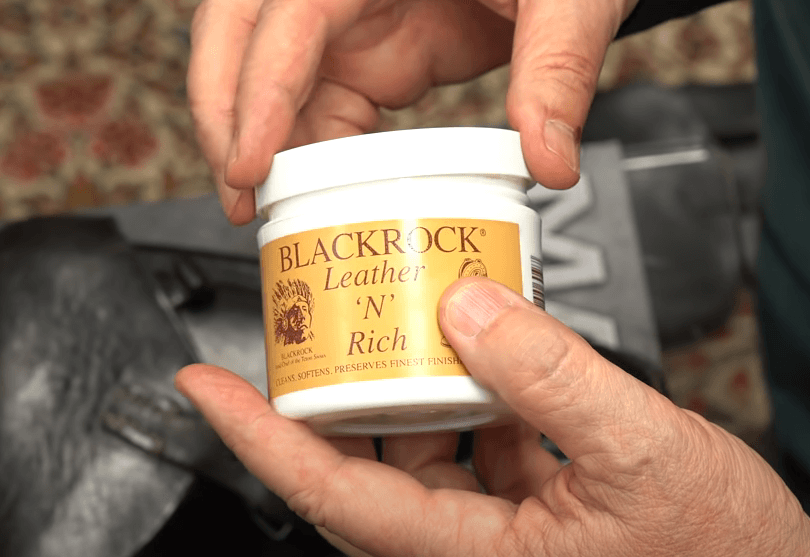
But the here's another hack. The easiest way to get care products for your leather is an auto body shop, not auto body but auto supply store. Go to an auto supply store and they will have leather preservative for your leather seats. And whatever is good for leather seats is also good for leather holsters.
Applying Leather Preservative
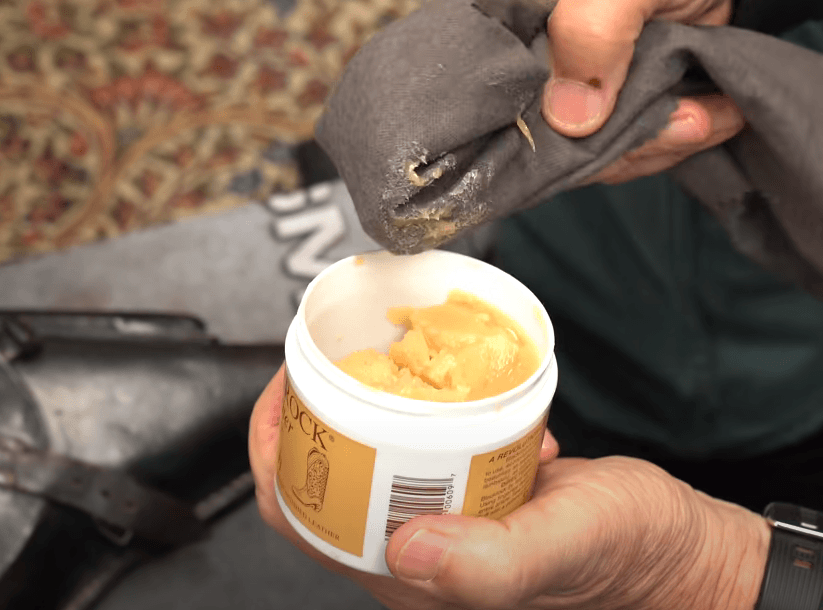
Just so you know this, this jar I've had for about five years and I do use it fairly often, I use a different rag than my oily rag and you only need a very little bit. You can see that I haven't used much and that's because I just take a very little, a little dab will do you, a little bit and you can get a lot of this holster covered. And you can see I get the whole top covered and I don't want to like load it up with wax. And it does clean it by the way, there's dirt coming off of that. I'll get a little bit off here and do the back, this one actually has been well cared for. But depending on where you live, so for example, when I said put things in the safe -- well look how nice that looks. Let's do that. Let's do the whole thing and don't want to leave, leave the job half done. Look at that. I would of course spend more time I try not to by the way, cover the stitching because that will get a waxy build-up and change the color of the stitching. So I want to keep the stitching as white as possible. And so when I when I'm doing this I usually just stay off the stitching and just do the leather but you can you can see the condition of that holster with a little bit of preservative on it.
Watch out - Humidity can be an issue
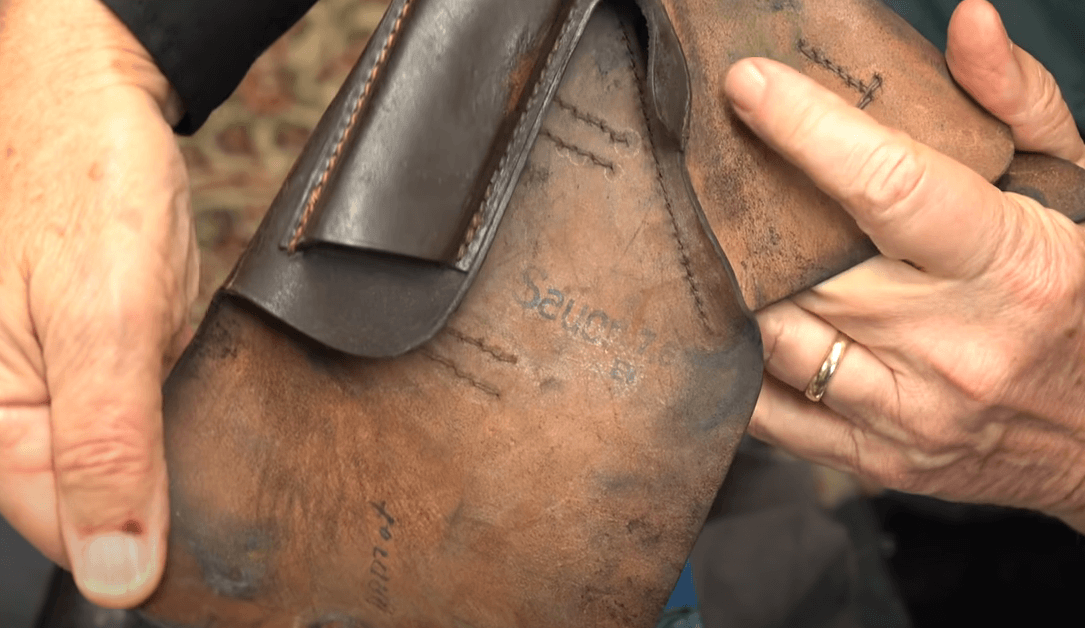
And what I started to say, when I put the guns away in the safe in this area, humidity is an issue. So even in the dead of winter we still have about 30% - 40% humidity, which is fine for the holsters and fine for the gun. But if you live in Arizona, where you regularly have a very very dry climate, the problem is, the holster will dry out. The gun loves it by the way, the gun loves the dryness but the holster does not. So you can see this almost feels like plastic, but this is leather that is just completely dried out. You can see it starting to crack at the top. Now it's almost too late to remediate this holster, meaning I can treat it but it's not going to do much good about the current cracking but I can stop it from cracking anymore. But this is another would have been a very valuable holster if somebody had cared for it. Because it is Sauer 7.65, wartime holster.
Way too much oil on this one

And let's just see if we can bring back some of the life to this one. This one has actually been oiled up a lot in fact, I suspect that somebody just took gun oil, they wipe down their gun and then wipe down the holster. This is very soft and pliable almost too much oil. This is like Little Red Riding Hood wasn't the three isn't the three little bear. This is like the three little bears too much a too much oil and wax. Not enough and just right. Let's work on this one a little bit. This is no idea what this is going to do. But I did put a generous portion just to hit this where it's all cracked at the top. And you get the idea.
Apply and wait a day
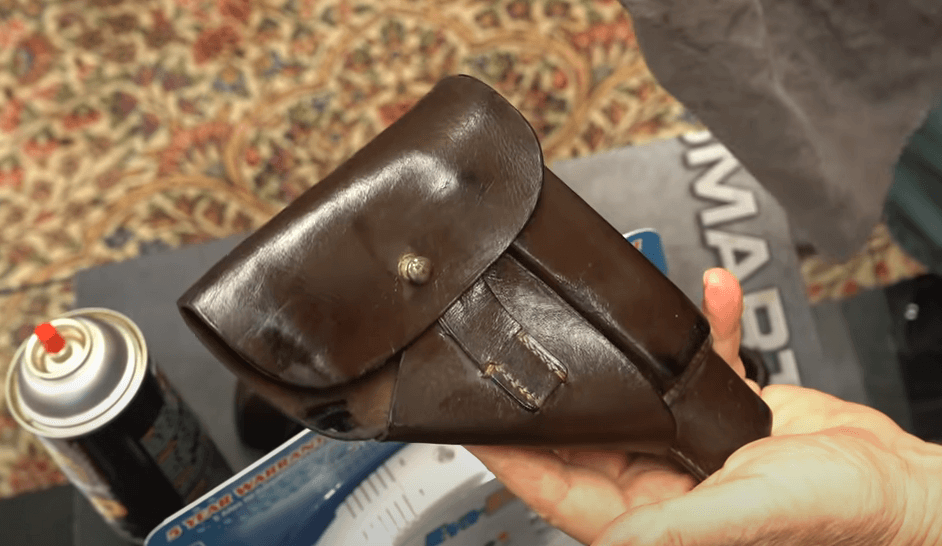
Okay, that was that was about less than a minute. And by the way that looks too shiny to you and you say, oh crap, I don't want it to look like that. Trust me, wait a day, tomorrow that all just soaks in and it'll not look at all like this. I can't do time lapse, I could, but I just don't feel like it. This will soak in to the leather and make it a lot more pliable. And it'll be much better after that. This has had too much oil applied and it has been flattened, so that kind of hurt it.
Mold Spores - another issue
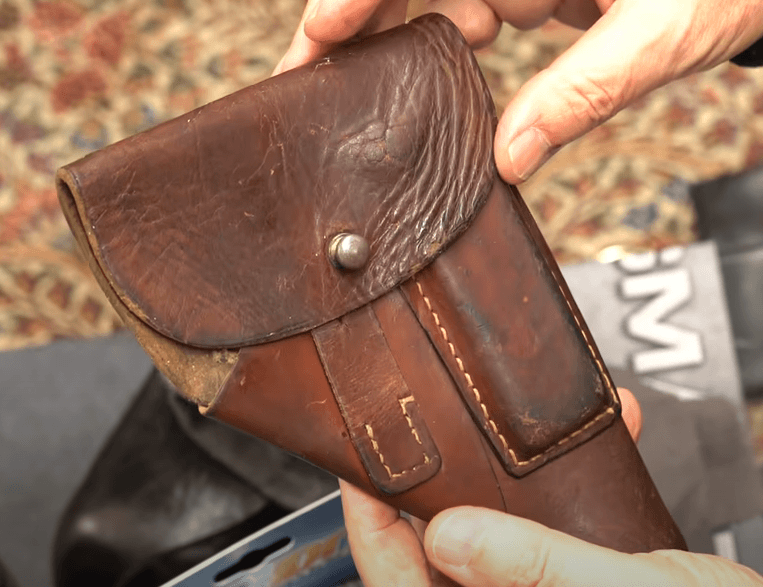
One other tip about this holster. When I open it up and this is a very serious issue and particularly in humid areas. So again, Southeast United States, certainly where I am, we have a problem with this, these little mold spores. Now I've opened up my safe and had mold spores all over the holster, it just completely covered the holster. And if you just wipe it down, by the way, take an oily cloth and just wipe it away, it'll take the mold spores away. But the problem is, they're down inside here. They're down inside the pouch. They're also down inside here, you can't see them. But especially for a pebble grain or a pigskin, these little spores get in there. And if you wipe them all down, it'll remove the obvious ones but the ones down there will just continue to grow and reproduce. And so they come back.
Baking Holsters
So I did a video on cooking it in the oven. And I said heat it up at 200 degrees Fahrenheit, but unfortunately somebody in Europe thought Fahrenheit and Celsius were the same thing. And so he put it in the oven at 200 degrees Celsius and let me just say it looked like a charred piece of beef. Here it is. Okay, just kidding. But he did cook his holster and was very upset with me. So I got a new hack for you.
Yet another hack
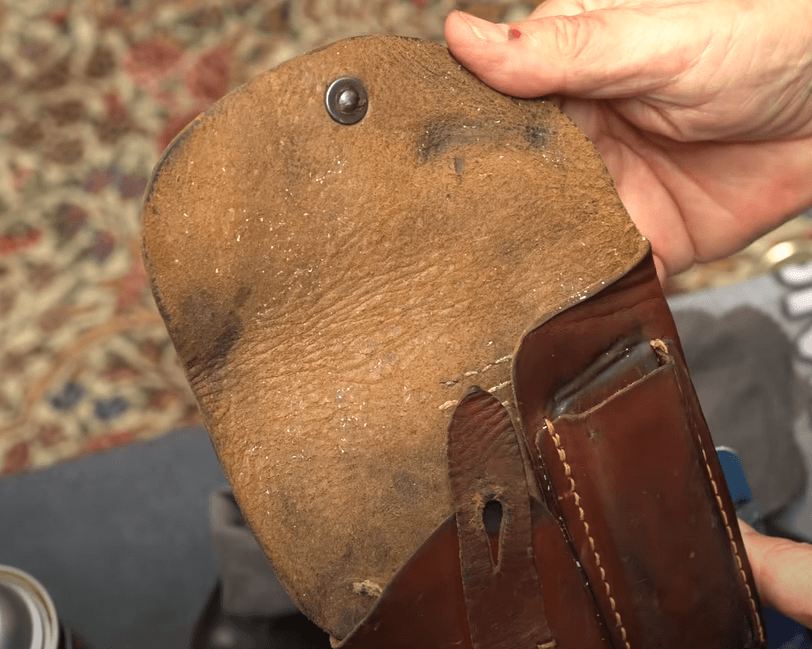
The hairdryer, let's check it out. You will watch live, remember when I opened while I opened up a pack of cigarettes for the first time, I opened up a holster the first time, I shot off a flare that didn't work for the first time. Now I'm going to remove these mold spores for the first time. Live on TV. Come on over.
Another Live
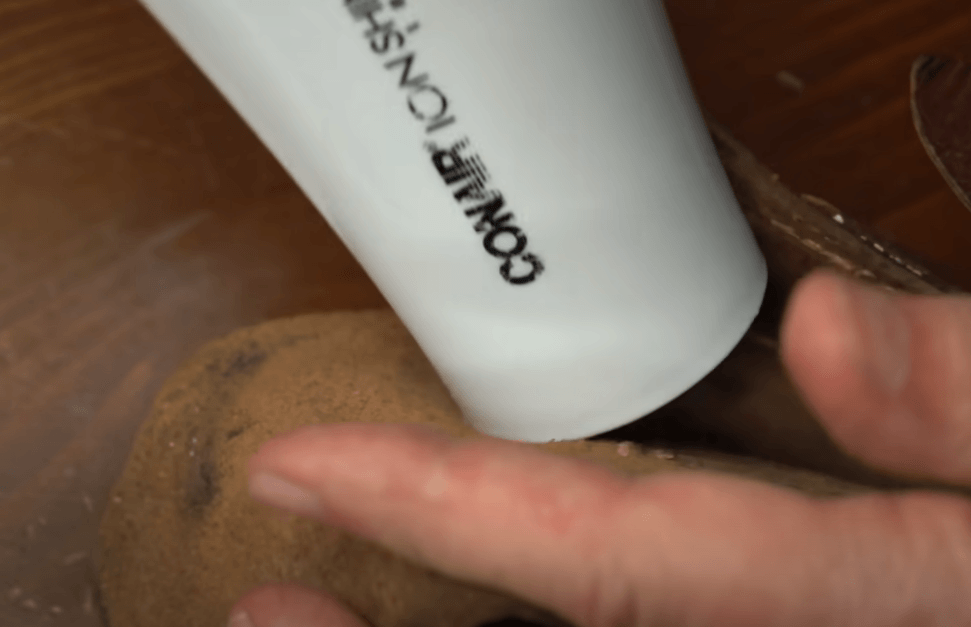
Okay, this morning I snuck out of the house I took my wife's hairdryer. I sure hope she doesn't find out that I used it on a on a smelly holster. We'll get it back and she for sure won't watch this video. Let's try it out. So you see it disappear right before your eyes. I'll hit this part over here too. Because once it starts to grow, it'll spread to your other holsters, if you have them piled on top of each other. And getting in here is very easy because it's basically the heat that kills the spores. Let's get down in here, you can see it down in here. So I'm going to get rid of it. Okay here, I'm just putting it down inside here. Put it down inside here. Again the oven works. See that, it just disappeared right in that crack. It gets into the stitching and it's really hard to get rid of if you just wipe it down but this heat was perfect. And that gets rid of everything all the way down inside. And that's the best way to get rid of the mold spores. Oh look at that. I'm enjoying this by the way. So let's just do it one more time. It gets in the crevices. Here it goes. And as they would say on the infomercial, BAM.
Flashback to the cracked holster
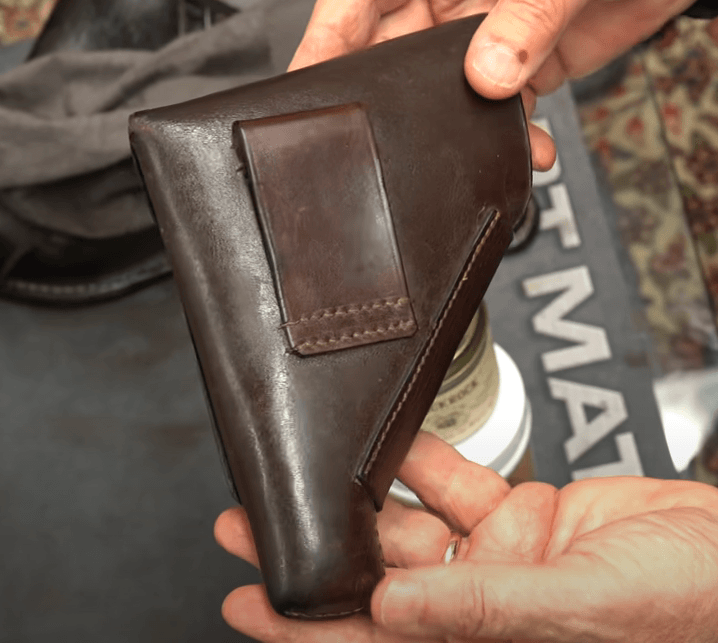
Hey, I just came back to this holster. This was the one that was all cracked. And that was only a five minute break and you can already see that this is starting to soak into the leather and it has just a little bit of a shine but not too much. Now I mentioned the leather product. I actually bought about 20 of these. If you'd like one, it does last a long time. This really lasts a long time and this would be $20 shipped, if you want some, I bought about 20 off the U, but you can get them from Brownells, your oil from Brownells you can get them from Amazon, whatever is easiest for you and of course support your local Gun Shop because they will at least have the gun oil for sure, they may not have the leather product.
Keep them wrapped and control the climate
Hey, that was fun and I hope mildly entertaining. Again, the most important thing is climate control. Your attic is probably not the best place, it is great for guns but it's really bad on holsters. I keep my safes in the basement because the other reason is they're heavy and I don't want to come through the ceiling in the attic all the way to the basement. So I keep my safes in the basement. So I keep dehumidifiers down there and I also keep a dehumidifier in the safe. So you want it to be dry enough to keep the metal from rusting and corroding but moist enough that your holsters don't dry out. So just think climate control and make sure you keep the guns wrapped if they're in here and the guns wrapped if they're in the box that kind of holds them holds the oils up against the metal.
That's a wrap!
Hey, thanks for watching and you got through Gun Collecting 101 make sure you like and subscribe to our channel and we'll be back with more tips real soon.
